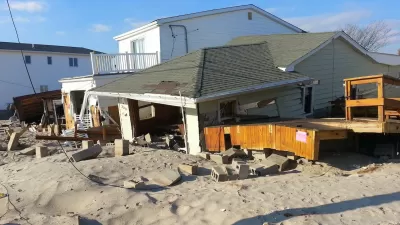Hurricane Sandy made New York's increasing vulnerability to extreme storms apparent, and the need elevate buildings in flood-prone areas imperative. This task is made particularly challenging due to the prevalence of multistory buildings.
"Up and down the coast of New York and New Jersey, property owners are being forced to raise their homes and businesses above a new 100-year floodplain drawn up and mandated by the Federal Emergency Management Agency," writes Matt Chaban.
"FEMA does this all over the country, but by-and-large, New York looks different than a lot of these places," said Howard Slatkin, the Department of City Planning's director of sustainability. "In addition to small homes, we've got rowhouses and apartment buildings and a streetscape we want to maintain."
"On Monday, the city put forward its plan to address these problems by certifying a slew of proposed zoning changes that would allow for the elevation of buildings. For the past seven months, Mr. Slatkin and a team at the City Planning Department have been wrestling with the challenge of coming up with a way to fortify the city against future storms without destroying the urban character that makes New York unique."
"If buildings must be raised five, eight, even 12 feet up on stilts, planners fear it could deaden New York's vibrant street life along coastal areas," notes Chaban. "In other words, will Jane Jacobs float?"
FULL STORY: A storm-proof way to elevate city buildings

Alabama: Trump Terminates Settlements for Black Communities Harmed By Raw Sewage
Trump deemed the landmark civil rights agreement “illegal DEI and environmental justice policy.”

Study: Maui’s Plan to Convert Vacation Rentals to Long-Term Housing Could Cause Nearly $1 Billion Economic Loss
The plan would reduce visitor accommodation by 25% resulting in 1,900 jobs lost.

Why Should We Subsidize Public Transportation?
Many public transit agencies face financial stress due to rising costs, declining fare revenue, and declining subsidies. Transit advocates must provide a strong business case for increasing public transit funding.

Wind Energy on the Rise Despite Federal Policy Reversal
The Trump administration is revoking federal support for renewable energy, but demand for new projects continues unabated.

Passengers Flock to Caltrain After Electrification
The new electric trains are running faster and more reliably, leading to strong ridership growth on the Bay Area rail system.

Texas Churches Rally Behind ‘Yes in God’s Back Yard’ Legislation
Religious leaders want the state to reduce zoning regulations to streamline leasing church-owned land to housing developers.
Urban Design for Planners 1: Software Tools
This six-course series explores essential urban design concepts using open source software and equips planners with the tools they need to participate fully in the urban design process.
Planning for Universal Design
Learn the tools for implementing Universal Design in planning regulations.
Caltrans
Smith Gee Studio
Institute for Housing and Urban Development Studies (IHS)
City of Grandview
Harvard GSD Executive Education
Toledo-Lucas County Plan Commissions
Salt Lake City
NYU Wagner Graduate School of Public Service




























